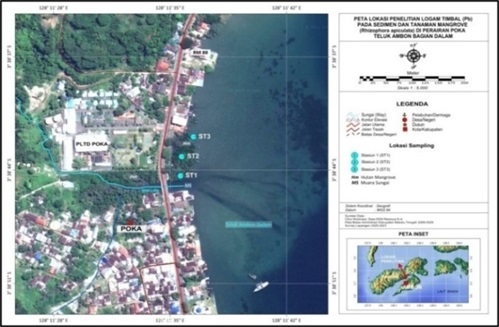Bioaccumulation of Lead Metal (Pb) by Mangrove Plants (Rhizopora apiculata) in the Waters of Poka Village, Inner Bay of Ambon
Abstract
This research aims to study the extent of bioaccumulation of the heavy metal Pb by mangrove plants (Rhizopora apiculata) in the waters of Poka Village, Ambon Bay. Mangrove plants were chosen because they can naturally accumulate heavy metals around their roots. In this study, sediment grains were measured using a Sieve Shaker, the content of Pb metal in sediment and parts of mangrove plants was determined using AAS, while the bioaccumulation value of Lead metal (Pb) by mangrove plants was calculated using the BCF and TF formulas. The results showed that the particle size in gravel ranged between 0.00-0.13%, sand 20.44-66.35%, and mud 33.65-79.56%. Lead (Pb) levels in Poka Village waters in sediment ranged from 10,925-16,925 mg/kg, roots ranged from 0.5-21.35 mg/kg, and leaves ranged from 0-4,675 mg/kg. Meanwhile, the BCF value at sampling point 1 = 0.03, sampling point 2 = 1.40 and sampling point 3 = 0.56, the TF value at sampling point 1 = 7.8, sampling point 2 = 0.03 and sampling point 3 = 0.09. This shows that mangrove plants function as phytoextraction and can be used as phytoremediation agents to accumulate the heavy metal lead (Pd) from waters.
Downloads

Copyright (c) 2024 Abraham Mariwy, Yeanchon H Dulanlebit, A. Ode

This work is licensed under a Creative Commons Attribution-NonCommercial-NoDerivatives 4.0 International License.
Authors who publish with this journal agree to the following terms:
- Copyright on any article is retained by the author(s).
- The author grants the journal, the right of first publication with the work simultaneously licensed under a Creative Commons Attribution License that allows others to share the work with an acknowledgment of the work’s authorship and initial publication in this journal.
- Authors are able to enter into separate, additional contractual arrangements for the non-exclusive distribution of the journal’s published version of the work (e.g., post it to an institutional repository or publish it in a book), with an acknowledgment of its initial publication in this journal.
- Authors are permitted and encouraged to post their work online (e.g., in institutional repositories or on their website) prior to and during the submission process, as it can lead to productive exchanges, as well as earlier and greater citation of published work.
- The article and any associated published material is distributed under the Creative Commons Attribution-NonCommercial-NoDerivatives 4.0 International License.





_copy1.png)










